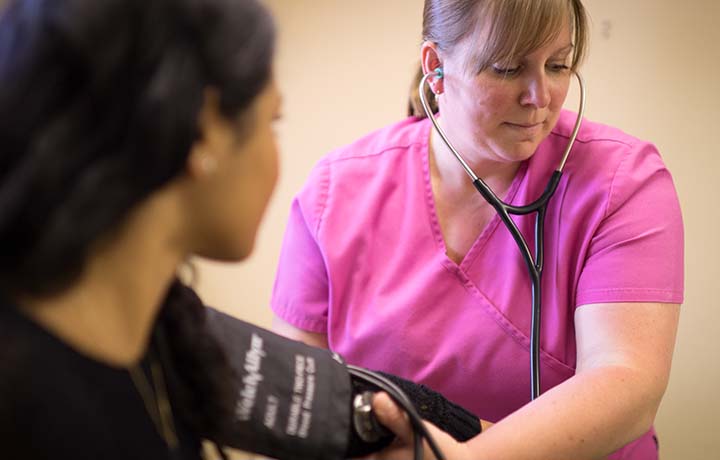Article
Developing a team of leaders at Partners HealthCare
By Jessica Sweeney-Platt | February 2, 2017

Physicians come to here to advance their research, clinical, and teaching skills. But Partners also has a deep commitment to developing physician leaders.
As chief medical officer for Brigham and Women's Physician Organization, Jessica Dudley, M.D., works to develop and implement her hospital's successful physician leadership programs. Dudley recently sat down with athenaInsight to discuss how Partners' programs work and the lessons they hold for other healthcare organizations.
Here are four key takeaways:
1. Data transparency is foundational to informal leadership development
Partners runs a number of formal physician leadership programs, but a tremendous amount of informal development work also takes place throughout the organization. One of the core mechanisms for that informal work is department-level quality improvement initiatives.
And the fuel for these efforts is transparent, peer-level data.
Even before Partners moved to digital record-keeping, the organization shared peer-level data on prescription patterns. (“It was the only clean data we could find," Dudley says.) Partners used this prescribing pattern data to spark a discussion about what the evidence indicated was best for the patients, versus what was recommended by drug company representatives.
With the advent of electronic health records, these efforts have become much broader. Most individual departments engage in extensive discussions on how to address variation in clinical practice, all of which are grounded in data that allow physicians to compare their own practice decisions to those of their peers.
At the center of all of those conversations is a commitment to transparent data sharing and analysis
“Everybody has a lot of questions about the validity of the data," Dudley says. “Everybody will always say, 'My patients are sicker,' or, 'This isn't my patient.' But once we get through all of that, we can really look at it and say, 'No, this person is somehow able to…advance care for these patients in a more effective way. What are they doing that's different from what you're doing?' And how can we have a dialogue to figure out how to put the systems in place to get us all to a better place?"
Dudley also highlighted Partners' Director of Performance Improvement role, which creates a group of “connected and engaged" department-level physician champions. They focus not only on identifying improvement opportunities within their clinical departments, but on developing and defining valid, relevant quality measures for those departments.
These physician champions initiate and support conversations with their peers about what is most clinically relevant, and what they will hold one another accountable for, in terms of quality improvement and measurement.
And at the center of all of those conversations is a commitment to transparent data sharing and analysis.
2. Leadership development resources are best deployed toward physicians who are starting to build their influence networks
Among the formal leadership development programs Partners uses is the Brigham's Leadership Program, offered in conjunction with Harvard Business School. This 10-month program consists of many familiar leader development program elements, including a competitive application process for a final cohort of 60 physicians (so far, they have completed 6 cohorts). Participants spend two and a half days at a time on the Harvard campus, in classroom sessions with faculty, industry experts and senior Brigham executives. They complete real-world team projects designed to address actual problems faced by the organization.
Dudley says the organization seeks applicants with a commitment to improving the organization. But she also wants to capture developing leaders at a specific point in their careers.
“We actually don't want the most junior folks who have just finished [residency]," she says. “We're looking for somebody who's had a little bit more experience because we need them ultimately to bring their peers along with them."
There's a lesson here for health systems: For leadership development to gain traction, it must be targeted at people who have enough experience to understand the context, but aren't so far along in their careers that they've developed entrenched habits that are hard to break.
3. Building social cohorts is an implicit goal for every program
All of the leadership development programs that Partners and the Brigham offer to physicians share a commitment to building and reinforcing social cohorts across clinical areas. Whether it's the Physician Leadership Program at Harvard, the Clinical Process Improvement Program, or even shorter programs like Negotiations — a program specifically focused on building constructive negotiation skills — all reinforce the idea that collegial relationships are critical to long-term success.
Given the industry-wide concern over physician burnout, Dudley believes that social connections are a crucial ingredient to ensure that physicians have a work environment that feels supportive and allows them to practice at the top of their capabilities.
4. Effective programs not only teach concrete skills, but reset the participants' mindset about the larger organization
The Brigham's flagship Brigham Leadership Program leads participants to three distinct realizations, Dudley says.
First, she says: “There's a lot of knowledge out there that I don't have". Even a physician who's the world's best in his or her specialty might not know much about business, strategy, and myriad other subjects.
Introducing these doctors to a broader set of disciplines, and providing concrete business skills and vocabulary, leads to continued interest in, and engagement with, these knowledge sets.
Second: “This ecosystem within a healthcare institution and across a delivery system is complex, and the approaches to addressing challenges are not simple." Dudley says the leadership programs help physicians develop a broader understanding of the health system, which is a critical step in overcoming any “me-versus-them mentality" and accepting that "we're all in this together. We have to roll up our sleeves and work collectively."
Third: "I've got a team at my back." By working with teams on projects, leadership program participants realize they aren't alone, Dudley says. “There's a whole cohort of people that they may never have seen before, but are now working to solve this problem collaboratively." Indeed, the cohort within the leadership program, ideally becomes a team physician leaders can rely on when they return to their day-to-day work.
A singular challenge for physician leadership development programs is figuring out how to start physicians on a journey from individual contributor to peer influencer to organizational influencer. The Leadership Program at the Brigham represents a best-in-class approach to beginning that journey. It targets physicians who are just starting to form their influence networks, and provides them with tools, resources and, most importantly, perspective to grow and strengthen those networks.
In the process, Partners is reinforcing participants' connections not just to their departments or their physician colleagues, but to the larger enterprise, in all its complexity and (occasionally) contradictions. Because, as Dudley points out, these skills are critically important to the future of healthcare.
“What 20 years ago might have been a 'nice to have,' is now seen as a 'must have,'" she says. “We need physicians who understand the challenges facing all of us and are excited to roll up their sleeves, address these challenges, and improve upon it."
Jessica Sweeney-Platt is executive director of research at athenahealth. Illustration by Michelle Kondrich.







